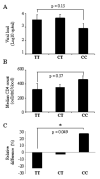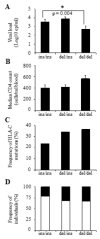High frequency of HIV mutations associated with HLA-C suggests enhanced HLA-C-restricted CTL selective pressure associated with an AIDS-protective polymorphism
- PMID: 22474021
- PMCID: PMC3378658
- DOI: 10.4049/jimmunol.1103472
High frequency of HIV mutations associated with HLA-C suggests enhanced HLA-C-restricted CTL selective pressure associated with an AIDS-protective polymorphism
Abstract
Delayed HIV-1 disease progression is associated with a single nucleotide polymorphism upstream of the HLA-C gene that correlates with differential expression of the HLA-C Ag. This polymorphism was recently shown to be a marker for a protective variant in the 3'UTR of HLA-C that disrupts a microRNA binding site, resulting in enhanced HLA-C expression at the cell surface. Whether individuals with "high" HLA-C expression show a stronger HLA-C-restricted immune response exerting better viral control than that of their counterparts has not been established. We hypothesized that the magnitude of the HLA-C-restricted immune pressure on HIV would be greater in subjects with highly expressed HLA-C alleles. Using a cohort derived from a unique narrow source epidemic in China, we identified mutations in HIV proviral DNA exclusively associated with HLA-C, which were used as markers for the intensity of the immune pressure exerted on the virus. We found an increased frequency of mutations in individuals with highly expressed HLA-C alleles, which also correlated with IFN-γ production by HLA-C-restricted CD8(+) T cells. These findings show that immune pressure on HIV is stronger in subjects with the protective genotype and highlight the potential role of HLA-C-restricted responses in HIV control. This is, to our knowledge, the first in vivo evidence supporting the protective role of HLA-C-restricted responses in nonwhites during HIV infection.
Figures







Similar articles
-
Genetic interplay between HLA-C and MIR148A in HIV control and Crohn disease.Proc Natl Acad Sci U S A. 2013 Dec 17;110(51):20705-10. doi: 10.1073/pnas.1312237110. Epub 2013 Nov 18. Proc Natl Acad Sci U S A. 2013. PMID: 24248364 Free PMC article. Clinical Trial.
-
Comprehensive screening for human immunodeficiency virus type 1 subtype-specific CD8 cytotoxic T lymphocytes and definition of degenerate epitopes restricted by HLA-A0207 and -C(W)0304 alleles.J Virol. 2002 May;76(10):4971-86. doi: 10.1128/jvi.76.10.4971-4986.2002. J Virol. 2002. PMID: 11967314 Free PMC article.
-
Effect of Difference in Consensus Sequence between HIV-1 Subtype A/E and Subtype B Viruses on Elicitation of Gag-Specific CD8+ T Cells and Accumulation of HLA-Associated Escape Mutations.J Virol. 2021 Feb 24;95(6):e02061-20. doi: 10.1128/JVI.02061-20. Print 2021 Feb 24. J Virol. 2021. PMID: 33361435 Free PMC article.
-
HLA-C and HIV-1: friends or foes?Retrovirology. 2012 May 9;9:39. doi: 10.1186/1742-4690-9-39. Retrovirology. 2012. PMID: 22571741 Free PMC article. Review.
-
Progression of HIV to AIDS: a protective role for HLA-B27?AIDS Rev. 2004 Apr-Jun;6(2):89-96. AIDS Rev. 2004. PMID: 15332431 Review.
Cited by
-
Epigenetic regulation of differential HLA-A allelic expression levels.Hum Mol Genet. 2015 Aug 1;24(15):4268-75. doi: 10.1093/hmg/ddv158. Epub 2015 May 1. Hum Mol Genet. 2015. PMID: 25935001 Free PMC article.
-
Response to Comment on "Influence of HLA-C expression level on HIV control".Science. 2013 Sep 13;341(6151):1175. doi: 10.1126/science.1241854. Science. 2013. PMID: 24031003 Free PMC article.
-
The MHC in the era of next-generation sequencing: Implications for bridging structure with function.Hum Immunol. 2019 Jan;80(1):67-78. doi: 10.1016/j.humimm.2018.10.002. Epub 2018 Oct 12. Hum Immunol. 2019. PMID: 30321633 Free PMC article. Review.
-
The New Kid on the Block: HLA-C, a Key Regulator of Natural Killer Cells in Viral Immunity.Cells. 2021 Nov 10;10(11):3108. doi: 10.3390/cells10113108. Cells. 2021. PMID: 34831331 Free PMC article. Review.
-
Host genetics of HIV acquisition and viral control.Annu Rev Med. 2013;64:203-17. doi: 10.1146/annurev-med-052511-135400. Epub 2012 Sep 27. Annu Rev Med. 2013. PMID: 23020875 Free PMC article. Review.
References
-
- Fellay J, Ge D, Shianna KV, Colombo S, Ledergerber B, Cirulli ET, Urban TJ, Zhang K, Gumbs CE, Smith JP, Castagna A, Cozzi-Lepri A, De Luca A, Easterbrook P, Gunthard HF, Mallal S, Mussini C, Dalmau J, Martinez-Picado J, Miro JM, Obel N, Wolinsky SM, Martinson JJ, Detels R, Margolick JB, Jacobson LP, Descombes P, Antonarakis SE, Beckmann JS, O’Brien SJ, Letvin NL, McMichael AJ, Haynes BF, Carrington M, Feng S, Telenti A, Goldstein DB. Common genetic variation and the control of HIV-1 in humans. PLoS Genet. 2009;5:e1000791. - PMC - PubMed
-
- Fellay J, Shianna KV, Ge D, Colombo S, Ledergerber B, Weale M, Zhang K, Gumbs C, Castagna A, Cossarizza A, Cozzi-Lepri A, De Luca A, Easterbrook P, Francioli P, Mallal S, Martinez-Picado J, Miro JM, Obel N, Smith JP, Wyniger J, Descombes P, Antonarakis SE, Letvin NL, McMichael AJ, Haynes BF, Telenti A, Goldstein DB. A whole-genome association study of major determinants for host control of HIV-1. Science. 2007;317:944–947. - PMC - PubMed
-
- Thomas R, Apps R, Qi Y, Gao X, Male V, O’HUigin C, O’Connor G, Ge D, Fellay J, Martin JN, Margolick J, Goedert JJ, Buchbinder S, Kirk GD, Martin MP, Telenti A, Deeks SG, Walker BD, Goldstein D, McVicar DW, Moffett A, Carrington M. HLA-C cell surface expression and control of HIV/AIDS correlate with a variant upstream of HLA-C. Nat Genet. 2009;41:1290–1294. - PMC - PubMed
-
- Catano G, Kulkarni H, He W, Marconi VC, Agan BK, Landrum M, Anderson S, Delmar J, Telles V, Song L, Castiblanco J, Clark RA, Dolan MJ, Ahuja SK. HIV-1 disease-influencing effects associated with ZNRD1, HCP5 and HLA-C alleles are attributable mainly to either HLA-A10 or HLA-B*57 alleles. PLoS One. 2008;3:e3636. - PMC - PubMed
Publication types
MeSH terms
Substances
Grants and funding
LinkOut - more resources
Full Text Sources
Medical
Research Materials

